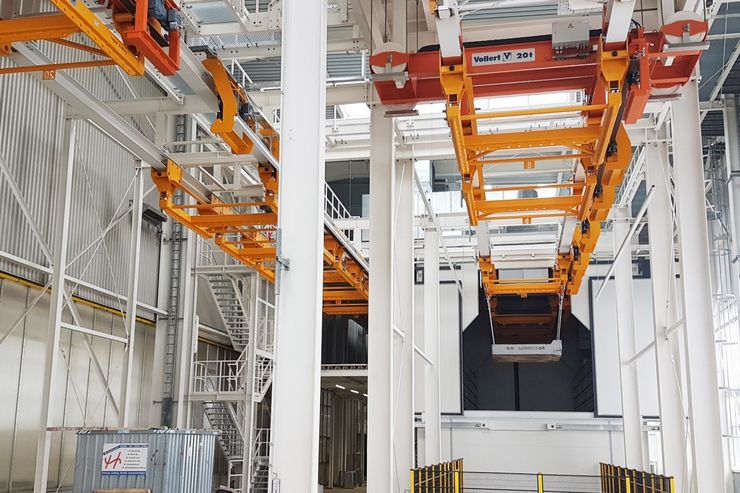The Liebherr-Werk Ehingen GmbH (Germany) is one of the world’s leading manufacturers of mobile cranes. The crane portfolio includes state-of-the art telescopic and lattice boom cranes on mobile and crawler undercarriages with lifting capacities of up to 3,000 t. They are used, for example, in ports, for bridge construction or for erecting wind turbines. A new wet painting plant is used to coat steel ballast elements, which serve as the necessary counterweight for the heavy lifting work.
Ballast in its most beautiful form
Liebherr offers its customers a wide choice of colors for the paint finish. At the same time, the ballast elements have different shapes and sizes up to a maximum of 4.5 × 2.45 m and a weight of up to 12.5 t, depending on the type of crane. In order to reduce the previously high proportion of manual work, Vollert was commissioned to redesign the coating process. On an area of around 110 m in length and 20 m in width, the work stations for washing, adhesive water drying, grinding, priming, evaporating, top coating, as well as for drying, cooling, gluing and marking are now lined up one after the other. Vollert coordinated the planning of the entire plant and supplied the conveyor technology with control system as well as the steel structure for the conveyor system and the steel structure for the newly built hall section. The painting technology was supplied by Heimer Lackiertechnik from Bielefeld, Germany.
Optimally timed with friction wheel and rope conveyor technology
After delivery on transport trolleys, a loading crane takes over the ballast elements at the start of the new line. They are attached to a product carrier individually or in groups of up to 20 t. For this purpose, the overhead crane lowers the empty product carrier and optimally positions the same by radio control with the aid of a trolley and its integrated slewing gear. It then lifts the product carriers, turns them by up to 270° depending on their position, and feeds them into the painting system. At the end of the line, an unloading crane of the same design places the finished work pieces back lengthwise onto a waiting transport trolley at 30-minute intervals. The empty product carriers are then returned to the starting point via a parallel return line using a rope conveyor system. Up to eight product carriers can be transported simultaneously and a total of 25 product carriers are in continuously synchronized circulation. Instead of chain conveyors or individual drives on the transport units, the concept uses permanently installed friction wheels for individual feed. The high total weight of the parts and the requirement for ergonomic height adjustment in the painting booths would not have been possible with a chain conveyor. When washing, grinding, painting and processing large parts, the lifting and lowering devices ensure an ergonomic working height. Individual loading and unloading can also be easily solved with a trolley, slewing gear and the known friction wheel concept.
The complete article was published in IST 03/2021.
Autor(en): Vollert Anlagenbau GmbH, Weinsberg (Germany)




